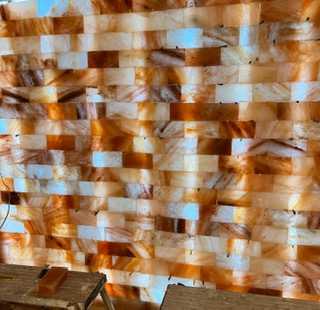The art of cooking is constantly evolving, with chefs and home cooks alike seeking innovative ways to enhance flavors and create unique dining experiences. One such method gaining popularity is using Himalayan salt bricks and pink salt walls in culinary applications. These natural salt products add a touch of elegance to the presentation, impart a distinct flavor, and enhance the cooking process. This article will explore the benefits, uses, and techniques of using Himalayan salt brick and pink salt walls to enhance culinary delights.
Understanding Himalayan Salt:
Origins and Formation
Himalayan salt, also known as pink salt, is mined from the Khewra Salt Mine in the Punjab region of Pakistan. It is believed to have formed millions of years ago when the ancient sea evaporated, leaving behind a rich deposit of minerals.
Nutritional Composition
Himalayan salt is packed with essential minerals like magnesium, potassium, and calcium, making it a healthier alternative to refined table salt. Its distinctive pink hue is due to trace minerals such as iron oxide.
Culinary Benefits
Enhanced Flavor: Himalayan salt imparts a subtle yet complex flavor to dishes, elevating the taste profile of various ingredients.
Moisture Retention
Salt bricks and walls help to retain moisture when cooking, resulting in juicier and more succulent meats and vegetables.
Versatile Use
Himalayan salt can be used in various culinary applications, including cooking, grilling, curing, and even as a presentation tool.
Himalayan Salt Brick: A Overview
Composition and Appearance
Himalayan salt bricks are solid blocks made from compacted granules of pink salt. They are typically rectangular and have a smooth, polished surface.
Heat Retention
Salt bricks have excellent heat retention properties, making them ideal for cooking and grilling.
Cooking Techniques:
Direct Cooking
Salt brick can be heated on stovetops, grills, or in the oven and used as a cooking surface. Foods such as meats, fish, and vegetables can be cooked directly on the heated salt brick, resulting in a unique and flavorful sear.
Chilled Applications
Salt brick can also be chilled in the refrigerator to serve cold appetizers, such as sushi or ceviche. The salt brick’s cold temperature helps keep the food fresh while imparting a subtle saltiness.
Maintenance and Care
Cleaning
Salt bricks should be cleaned with a damp cloth to remove any food particles after each use. It is important not to immerse the brick in water as it may dissolve.
Storage
Salt brick should be stored in a cool, dry place to prevent moisture absorption.
Pink Salt Walls: A. Overview
Decorative and Functional
Pink salt walls are constructed using blocks or panels made from Himalayan salt. They serve as decorative and functional tools in culinary settings.
Air Purification
When heated, pink salt walls release negative ions, which can help purify the air and create a healthier cooking environment.
Uses in Culinary Settings
Salt Aging
Pink salt walls can be used for dry-aging meats, such as beef or pork, by hanging them in a controlled environment. The salt aids in drawing out moisture while infusing flavors, resulting in tender and flavorful cuts.
Salt Block Plating
Pink salt walls can be used as unique serving platters, adding a visually stunning element to dishes like sushi, charcuterie, or desserts.
Maintenance and Care
Cleaning
Pink salt walls can be wiped down with a dry cloth to remove dust or debris. Not using water or any cleaning agents is essential as it may dissolve the salt and damage the wall. Maintenance: Pink salt walls are relatively low-maintenance. However, monitoring for any signs of erosion or degradation over time is important. The salt blocks or panels can be replaced if necessary to maintain the wall’s integrity.
Culinary Techniques and Tips
Salt Block Preheating:
Before cooking on a salt brick, it is crucial to preheat it gradually to avoid cracking. Start with low heat and gradually increase the temperature to allow the salt to heat evenly.
Proper Searing
When cooking on a salt brick, it’s important to sear the ingredients quickly to prevent them from becoming too salty. The high heat and direct contact with the salt surface result in a flavorful sear, but monitoring the cooking process closely is essential.
Experiment with Different Ingredients:
Himalayan salt bricks and pink salt walls can be used with various ingredients, including meats, seafood, vegetables, and fruits. Do not get afraid of experimenting and discover new flavor combinations.
Adjusting Salt Levels
When cooking with Himalayan salt, remember that the saltiness can vary. Taste the food as you cook and adjust the amount of added salt accordingly to maintain a balanced flavor.
Presentation and Serving
Utilize the aesthetic appeal of Himalayan salt products by using salt brick as serving platters or incorporating pink salt walls into the presentation of your dishes. The natural beauty of the salt enhances the visual appeal of the food.
Conclusion
When incorporating Himalayan salt bricks and pink salt walls into your cooking, following some key techniques and tips is important. Preheating the salt brick gradually, searing ingredients quickly to avoid excessive saltiness, and experimenting with various ingredients are all essential for achieving the desired flavor profiles. Adjusting salt levels based on taste and utilizing the aesthetic appeal of salt products for presentation further enhance the culinary experience. Using Himalayan salt brick and pink salt walls allows you to unleash your creativity in the kitchen and take your culinary delights to new heights. Whether you’re a professional chef or a home cook, incorporating these natural salt products into your cooking repertoire can add a unique flavor, enhance the visual appeal of your dishes, and provide functional benefits. So, embrace the beauty and flavor of Himalayan salt and elevate your culinary creations to a whole new level.



